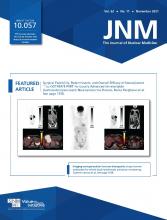TO THE EDITOR: We read with interest Rekowski and colleagues’ article (1), which reported improved response discrim-ination using ΔSUVmax compared with the Deauville scale (DS) for interim PET (iPET) in diffuse large B-cell lymphoma but assessed only complete metabolic response versus no complete metabolic response considering binary cutoffs of DS-1–DS-3 versus DS-4/DS-5 and DS-1/DS-2 versus DS-3–DS-5.
In a prospective blinded study on 189 patients with diffuse large B-cell lymphoma after 2 cycles of rituximab plus cyclophosphamide, doxorubicin, vincristine, and prednisone (R-CHOP), we reported that DS-5 was associated with inferior progression-free survival and overall survival compared with DS-1–DS-4 whereas no complete metabolic response (DS-4/DS-5) was not (2). DS-5 was defined as an SUVmax at least 3 times the SUVmax in liver and/or new lesions. DS-5 and international prognostic index were independent predictors in multivariable analysis; a change in SUVmax (ΔSUVmax) of less than 66% was predictive in univariable analysis only. Eleven of 14 patients with a ΔSUVmax of less than 66% had DS-5, suggesting that both identify an increased risk of treatment failure. Comparable findings have been reported after 1 (3) and 4 (4) cycles of R-CHOP and in Hodgkin (5) and primary mediastinal B cell (6) lymphomas, whereby only the proportion of patients with DS-5 had inferior progression-free survival and overall survival.
We recently reported a comparative study of reading methods and timing of iPET in 1,692 patients with diffuse large B-cell lymphoma (7). iPET after 2 and 4 cycles of R-CHOP significantly discriminated responders irrespective of reading method using DS-1-DS-3 or DS-1-DS-4, or a ΔSUVmax of at least 66% as a good response, with negative predictive values greater than 80%. This finding is relevant for clinical practice, in which R-CHOP is standard treatment and an early complete metabolic response using DS can be reassuring for patients and doctors. Multivariate hazard ratios at cycle 2 were 4.91 for DS-5 versus 2.93 for a ΔSUVmax of less than 66% and at cycle 4 were 6.20 for DS-5 versus 4.65 for a ΔSUVmax of less than 70%. Two-year progression-free survival for iPET2-positive patients was 36.7% (95% CI, 26.3%–51.5%) for DS-5 and 56.3% (95% CI, 48.5%–65.4%) for a ΔSUVmax of less than 66%. For iPET4-positive patients, 2-y progression-free survival was 33.3% (95% CI, 18.9%–58.7%) for DS-5 and 47.2% (95% CI, 33.4%–66.7%) for a ΔSUVmax of less than 70%. ΔSUVmax, however, identified a larger proportion of poor responders than did DS-5, 12.7% versus 5.6% of the population at cycle 2 and 10.2% versus 5.0% at cycle 4.
Considering de-escalation in trials, all reading methods detect a good response at cycle 2. Considering escalation, DS-5 identifies patients with the worst prognosis at cycles 2 and 4. Cycle 4 is the optimal timing for detection of a poor response, with more poor responders identified using a ΔSUVmax of less than 70%, but carries the disadvantage of later treatment escalation. Regardless of the method used, the positive predictive value is suboptimal, and combining baseline metabolic tumor volume (8) and circulating tumor DNA (9) with early metabolic and molecular response appears promising.
It is premature to abandon the Deauville criteria in diffuse large B-cell lymphoma.
DISCLOSURE
Sally F. Barrington is supported by the National Institute for Health Research (NIHR) (RP-2-16-07-001). King’s College London and UCL Comprehensive Cancer Imaging Center are funded by CRUK and EPSRC in association with MRC and the Department of Health and Social Care (England). The views expressed are the authors’ and not necessarily those of the NHS, NIHR, or Department of Health and Social Care. The PETRA project is supported by the Alpe d’HuZes/KWF fund, provided by the Dutch Cancer Society (VU 2012-5848). No other potential conflict of interest relevant to this article was reported.
Footnotes
Published online April 23, 2021.
- © 2021 by the Society of Nuclear Medicine and Molecular Imaging.







